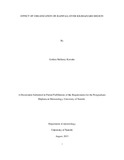| dc.description.abstract | Precipitation is a key link in the global water cycle and a proxy for changing climate. This study
sought to assess the effects of urbanization on precipitation in Kilimanjaro region based on
observed rainfall and population data between the period 1982 and 2012. Graphical analysis was
used to determine space time variability of rainfall amount, frequency and intensity while the
relationship between urbanization and rainfall was achieved through correlation and regression
analysis.
The slope of regression line showed that trend of total rainfall over urban areas (Moshi) was
decreasing more than rural areas (Kia and Same) with increasing frequencies of rainy days.
Annual rainfall showed highest peak in April and November with the number of rainy days
reducing with increasing threshold value of rainfall category. Graphical analysis indicated a
bimodal rainfall distribution over the region with highest peak during April –May –June and
lowest peak in November –December -January while the slopes of regression line were all noted
to be quite small with values of less than 0.3. Regression analysis indicated a positive
relationship between rainfall and population over all stations except same with coefficient of
determination (R2) values less than 9% and thus little influence of population on the amount of
rainfall received over Kilimanjaro region. Correlation analysis showed that rainfall and
population were negatively related over Lyamungu Moshi and Kia with correlation coefficient
values of -0.23, -0.16 and -0.30 respectively. At 95% significance level, the student t test showed
that these correlations were not significantly related to population as all values of t computed
were less than t tabulated.
Over Kilimanjaro region changes in population had little influence on rainfall amount, intensity,
and frequency over Kilimanjaro region. However, the slight modification in rainfall over
urbanized environment would necessitate convenient approaches and planning to help prevent
modification of rainfall and thus urban climate. Therefore, this information will form basis of
urban policy formulation towards limiting further changes in urban environment. | en |

